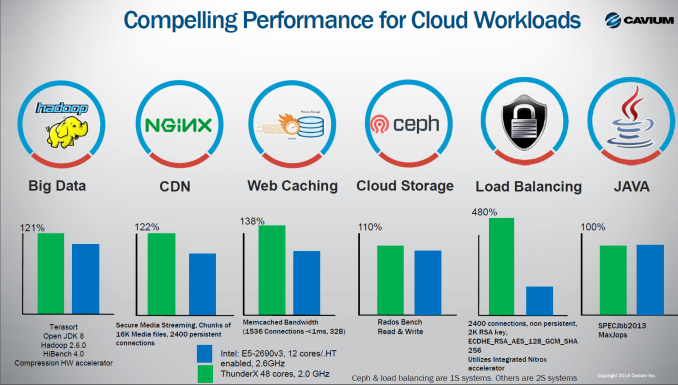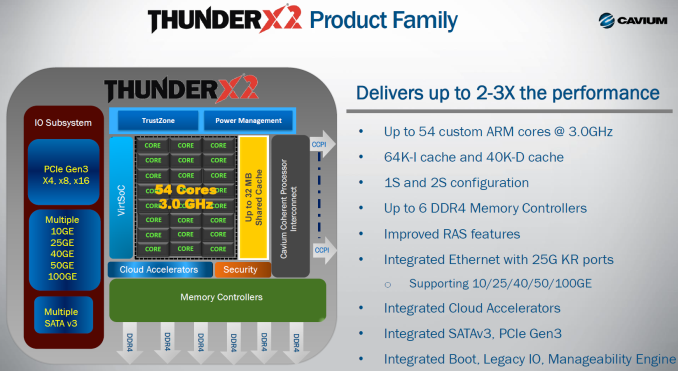Investigating Cavium's ThunderX: The First ARM Server SoC With Ambition
by Johan De Gelas on June 15, 2016 8:00 AM EST- Posted in
- SoCs
- IT Computing
- Enterprise
- Enterprise CPUs
- Microserver
- Cavium
Limitations of This Review
Before we get to our closing thoughts, I want to talk a bit about what we were and weren't able to do in our testing, and in what ways this limits our review. The still somewhat "rough on the edges" software ecosystem gave us a lot of headaches. Our setup was a Ubuntu 14.04 with lots of customized (Cavium's beta gcc compiler, MySQL version ThunderX 5.6) and newer software (the Linux kernel 4.2). The result was that we were slowed down by a large number of solvable (but time consuming) software and configuration problems.
Don't get me wrong: Linux on ARM has come a long way. Most software works, the exception was Spark 1.5 (Java based) which crashed with a very low level message. Still, it took quite a bit of time to get software configured correctly, while on x86 it is simply a matter of using "apt-get install".
Cavium told us that they expect that these problems will be solved in Ubuntu 16.04, and a firmware upgrade to support the new Ubuntu is on its way. That is also why we were not able to test our most real world and relevant benchmarks, such as our webserver tests. Webcaching, light webserving and Contend Delivery Networking might fit the ThunderX well as it has access to more memory and networking bandwidth than the Xeon D.
But webservers require a lot of software components (caching layer, webserver, interpreter etc.) that have to work together well. So we wait for 16.04 and the new firmware to arrive to build these complex tests.
Closing Thoughts
Exploring a new ambitious server SoC is always an interesting journey, but also a very time intensive one. We had to find out what the real performance profile of the ThunderX, not the perceived or advertised one. There have been both good and bad surprises in our journey.
Let's start with the bad: the blocking L1 cache, high latency L2-cache and high latency DRAM access are lowering the scalability of the 48 cores in a whole range of software. The ThunderX could still be a good candidate as front-end webserver, but Cavium has to solve the high power usage at low loads. Power management seems to be more problematic than single-threaded performance. Cavium promises that ThunderX2 will vastly improve power management by letting hardware handle much more of the management duties. But the current ThunderX power management capabilities seem to be rather basic. Cavium's information is sketchy at best.
The Xeon D, by comparison, offers superior performance per watt: twice as good as the ThunderX. It is clear that the ThunderX is not a good match for heavy database servers, nor for enterprise workloads where energy consumption at low load is a high priority.
The good. The 12 and 16-core Xeon Ds ($1300-$1800) and midrange E5s ($900-$2000, not including 10 GBe NICs) cost quite a bit more than the ThunderX ($800). Gigabyte could not tell us how much the R120-T30 would cost, only that the pricing would be "competitive with similar midrange Xeon E5 servers".
Although single-threaded performance is low, it is definitely not as terrible as commonly assumed. We found out that the raw integer computing power of the Thunder-X is about one-third that of the best Xeon Ds, not one-fifth as claimed in advertising materials (a difference of 65%). The ThunderX core is almost as good as the A57, while it consumes quite a bit less power and thus offers a better performance-per-watt than the latter. On the condition that you give it enough DRAM, the 48 cores are able to offer the Java performance of a midrange Xeon E5, even when we expect the system to remain under a certain response time.
Those facts – better than expected single threaded performance and midrange Xeon E5 throughput – make a world of difference. And we have yet to test the ThunderX in situations that is was really built for: network-intensive ones. The XML processing and h264 substests (SPEC CPU) indicate that there is definitely some truth in Cavium's claims that the ThunderX shines as a compute engine of a load balancer, web cache or CDN server.
As single threaded performance (SPEC CPU) is not as dramatic as commonly assumed and Java performance is already very close to what was promised, this puts the forthcoming ThunderX2 in a different light.
Using the new 14 nm FinFET technology of GlobalFoundries, Cavium claims it will reach 2.6-3.0 GHz and get a lot of microarchitectural improvements. This should result in twice as much performance per core. If indeed the ThunderX2 can offer single threaded performance at the level of the low end Xeon D (1.3-1.5 GHz), that might place it in the "SoCs with acceptable single threaded performance" and opens up new markets. Time will tell, but Cavium has proven it can deliver SoCs in a timely manner. And the fact that Cavium allows independent testing instead of just showing numbers on PowerPoint presentations tell us that they have confidence in the future of their ARMv8 endeavors.













82 Comments
View All Comments
Spunjji - Wednesday, June 15, 2016 - link
Well, this is certainly promising. Absent AMD, Intel need some healthy competition in this market - even if it is in something of a niche area.niva - Wednesday, June 15, 2016 - link
This is the area where profits are made, not "something of a niche area."Shadow7037932 - Wednesday, June 15, 2016 - link
Yeah, I mean getting some big customers like Facebook or Google would be rather profitable I'd imagine.JohanAnandtech - Thursday, June 16, 2016 - link
More than 30% of Intel's revenue, and the most profitable area for years, and for years to come...prisonerX - Wednesday, June 15, 2016 - link
This is the future. Single thread performance has reached a dead end and parallelism is the only way forward. Intel's legacy architecture is a millstone around its neck. ARM's open model and efficient implementation will deliver more cores and more performance as software adapts.The monopolists monopolise themselves into irrelevance yet again.
CajunArson - Wednesday, June 15, 2016 - link
" Intel's legacy architecture is a millstone around its neck."I wouldn't call those Xeon-D parts putting up excellent performance at lower prices and vastly lower power consumption levels to be any kind of "millstone".
"ARM's open model and efficient implementation "
What's "open" about these Cavium chips exactly? They can only run a few specialized Linux flavors that don't even have the full range of standard PC software available to them.
What is efficient about a brand-new ARM chip from 2016 losing at performance per watt to the 4.5 year old Sandy Bridge parts that you were insulting?
As for monopolies, ARM has monopolized the mobile market and brought us "open" ecosystems like the iPhone walled-garden and Android devices that literally never receive security updates. I'd take a plain x86 PC that I can slap Linux on any day of the week over the true monopoly that ARM has over locked-down smartphones.
shelbystripes - Wednesday, June 15, 2016 - link
You're right to criticize the "millstone" comment, Intel has done quite well achieving both high performance and high performance-per-watt in their server designs.But your comment about a "true monopoly" in the "locked-down smartphone" market is ridiculous. The openness (or lack thereof) that you're complaining about has nothing to do with the CPU architecture at all. An x86 smartphone or tablet can just as easily be locked down, and they are. I own a Dell Venue 8 7000, which is an Android tablet with an Intel Atom SoC inside. It's a great tablet with great hardware. But it's got a bunch of uninstallable crapware installed, Dell abandoned it after 5.1 (it's ridiculous that a tablet with a quad-core 2GHz SoC and 2GB RAM will never see Marshmallow), and the locked smartphone-esque bootloader means I can't repurpose it to a Linux distro even if one existed that supported all the hardware inside this thing.
On the flipside, the most popular open-source learning/development solution out there right now is the ARM-based Raspberry Pi. There are a number of Linux distros available for it, and everything is OSS, even the GPU driver.
TheLightbringer - Thursday, June 16, 2016 - link
You haven't done your homework.Some mobile devices were coming with Intel. But like Microsoft it entered the market too late, without offering any real value. The phrase "Too little, too late" fit them both.
ARM didn't do a monopoly. They just simply saw an opportunity and embrace it. In the early IBM clone days Intel licensed their architecture to allow competition and broad arrange of products. After the market was won, they went greedy, didn't licensed the architecture anymore and cut a lot of players out, leaving a need for a chip licensing scheme. And that's where ARM got in.
Google develops Android OS, but is up to phone vendors and carriers to deploy them. And they don't want to for economic reasons. They prefer to sell you a new phone for $$$.
Intel and MS got in the mobile/car market exactly what they deserve, nothing else.
junky77 - Friday, June 17, 2016 - link
they all greedy. Some just play it smartly or have more luck in decision makingBut, yea, when you read about the way IBM behaved when things were fresh - it's quite amazing. They had much of the market and could do a lot of stuff, but they simply had a very narrow mind set
soaringrocks - Wednesday, June 15, 2016 - link
You make it sound like it's mostly a SW problem, I think it's more complex than that. Actual performance is very dependent on the types of workload and some tasks fit Intel CPUs nicely and the performance per watt for ARM is lacking despite the hype of that architecture being uniquely qualified for low-power. It will be fun to watch how the battle evolves though.